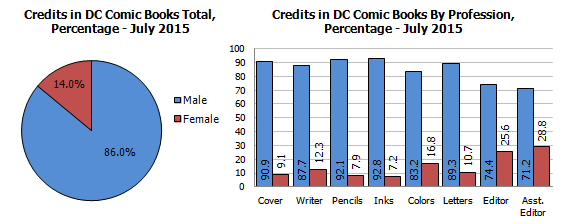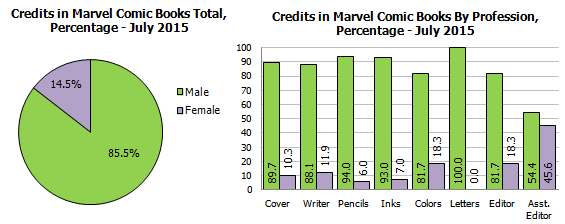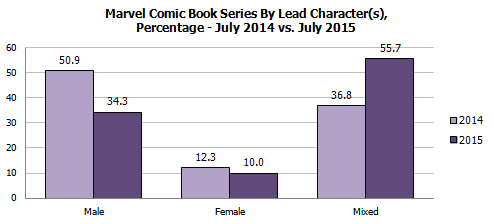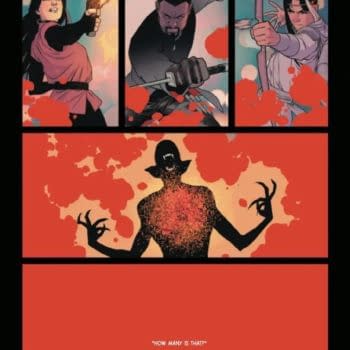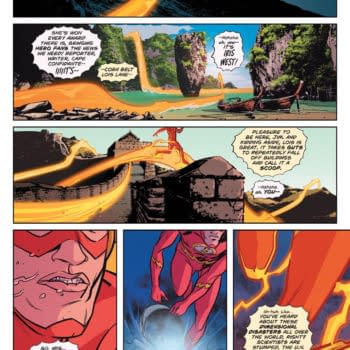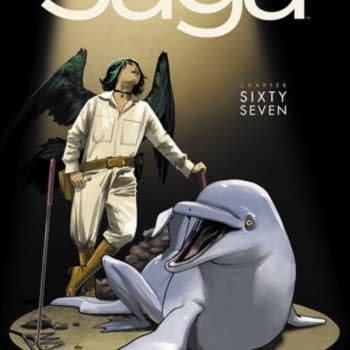Posted in: Comics, Recent Updates | Tagged: Comics, dc, dc comics, entertainment, gendercrunching, marvel, Marvel Comics, women in comics
Gendercrunching July 2015 – Combined Totals Rise For Marvel And DC, Plus Female Characters
By Tim Hanley
Both DC and Marvel saw gains for female creators in July, with strong numbers across the board contributing to one of the publishers' strongest combined totals. We also take a look at female characters at the Big Two to see whether their presence rose or fell over the past six months.
DC COMICS
The first month of #DCYou was underwhelming in June, showing no significant change from DC's pre-Convergence numbers, but July had some decent growth. In July 2015, DC Comics released 74 new comics featuring 643 credited creators, 553 men and 90 women. Let's look at their stats:
DC's overall percentage of female creators rose 1.8%, a solid jump for the publisher to a strong total. It was a mixed bag across the board, though: The first four categories each slipped down, most of them by 2-3%, but the next four went up. Colorists rose nearly 4%, letterers ticked up more than 6%, editors jumped 8%, and assistant editors were up 6%. Sizeable gains on the backend overcame the smaller losses at the front, resulting in overall growth and one of DC's better totals for a normal month without any special events momentarily inflating the numbers. It's good to see a net gain like this in a normal month, and hopefully DC keeps it up.
Compared To A Year Ago: DC was at 10.9% overall last July, so they've gained 3.9% since then.
MARVEL COMICS
Secret Wars continues to rage across the Marvel universe, and it seems to be working out well for female creators because Marvel's topped DC again. In July 2015, Marvel put out 73 new books with 621 credited creators, 531 men and 90 women. Here are the numbers:
After a good June, Marvel's overall percentage of female creators jumped 1% in July, a decent gain. The mid-14% range was a common high for Marvel a year or two ago, so it's nice to see them return to their past glory, such as it was. Editorial was responsible for a lot of the growth; cover artists, writers, and editors all rose a percentage point or so, but assistant editors shot up 6% to their best total in some time. Pencillers and inkers fell slightly, while colorists fell 4%, and letterers stayed at 0% yet again. Editorial carrying Marvel is nothing new, but when Marvel did that back in the day the strong editorial numbers were usually accompanied by paltry totals on the creative side of things. Now great editorial numbers are paired with decent creative numbers (relative to past totals). The big question now is can Marvel keep up this growth and strong showings after Secret Wars ends?
Compared To A Year Ago: Marvel was at 11.1% overall last July, so Marvel is up 3.4% since then.
FEMALE CHARACTERS AT DC AND MARVEL
Every six months we take a look at female character representation using a very simple metric: Who is on the covers? Cover images are how DC and Marvel advertise their books and communicate what is going on inside, so by tallying who appears on the cover we can get a rough sense of gender representation across each publisher's line.
The methodology is pretty straight forward; I just look at every cover and count up who is on it. There are a few weird rules, like I count anthropomorphic animals but not regular ones, so Scooby-Doo would count but Krypto wouldn't. I also try to simplify things with hordes of villains, so if twenty ninjas are attacking Daredevil or some such and all of the ninjas look about the same, they just count for one. I'm far more interested in the primary characters than legions of goons or random people in the background. Once I do the count, each book gets a percentage (so each comic is valued the same regardless of how many characters appear on the cover) and then the percentage gets averaged for each publisher.
Here are the numbers for female creators at DC and Marvel bi-annually for 2014 and 2015:
So good news! The books are more representative, and slightly closer to actual real world numbers, ie. 50-50. DC ticked up slightly, and is very near their past best, while Marvel's female character cover representation jumped more than 5% and put them higher than DC for the first time since we began tracking these numbers. While the low 30s is still a minority by a significant amount, DC and Marvel also posted their highest combined percentage in two years. Things are better, but there's still lots of room to improve.
Along with showing us characters, covers also tell us who is headlining the book, so let's take a look at how those numbers have changed since last July. I've divided every different series each publisher put out in July (if a book double shipped, it was only counted once) into three categories based on the lead characters: male, female, and mixed. So Superman is "male", Wonder Woman is "female", and Superman/Wonder Woman is "mixed." The categorization of team books depended on the team's makeup; Justice League is "mixed" (just barely) while A-Force is "female," for example.
We'll start with DC. Their July lineup included the second month of their new, supposedly more diverse #DCYou line, so let's see what's changed in a year:
More dudes, clearly. Male-led books jumped 7% to account for almost half of DC's line, while female-led books only rose 1% and are still in the teens. This was all at the expense of team books, which fell 8%. So what we're seeing here is an overall decrease in books with female representation. While female-led books went up slightly, their numbers were small to begin with and their other avenue for appearances, team books, took a tumble. In July 2014, 60.8% of DC's books featured a female character in a lead role, either solo or shared. In July 2015, this fell to 53.6%, which is barely more than half. Not to mention the fact that on a lot of these team books, female characters account for something along the lines of 1 of 6 team members most of the time.
Marvel is in the middle of Secret Wars, so they've got a vastly different lineup than they had a year ago. This has changed things dramatically:
Marvel's male-led books were down by a huge amount, tumbling 16% to roughly a third of all of Marvel's titles after accounting for more than half of their books last year. Female-led titles were down as well, falling 2.3% to a paltry 10%. However, mixed books skyrocketed, jumping 19% to account for well over half of Marvel's titles. As I pointed out above, mixed titles aren't always great for female characters, but Secret Wars has been decent in this regard. While DC tends to have just 1 or 2 female characters on a larger team, Marvel books like Runaways, Years of Future Past, and several others have been more evenly split. All together, female characters starred in 49.1% of Marvel titles, either solo or shared, last year but now that number has risen to 65.7%, nearly two thirds of their entire line. That's a big jump. Still, only 10% solo female titles is rough stuff.
Overall, we've got a mixed bag with female characters at the Big Two. They're appearing on more covers than they were six months ago, but "more" still doesn't even get them to a third. DC's combined percentage of books with a female lead, solo or team, dropped while Marvel's rose, but solo female-led series remain few at both publishers, Marvel especially. There are some encouraging signs in the numbers, but DC and Marvel are both still climbing up out of a deep hole when it comes to female character representation. The numbers moving from low to not quite as low isn't cause for celebration yet.
To learn more about this statistics project and its methodology click here, and to see the previous stats click here. You can visit Tim at Straitened Circumstances and follow him on Twitter @timhanley01. His book Wonder Woman Unbound: The Curious History of the World's Most Famous Heroine is available now.


